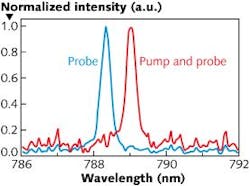BIOPHOTONICS: Optical protein switches at picosecond speeds

The development of all-optical data processing is getting a boost from European researchers who are pioneering the use of an optically active protein for ultrafast photonic switching.1 Their technique could one day achieve switching speeds faster than 1 Tbit/s. The group, from the Biological Research Centre of the Hungarian Academy of Sciences, the HAS Research Group of Laser Physics, and the University of Szeged (all in Szeged, Hungary) and the University of Witten/Herdecke (Witten, Germany) has based its experiment on bacteriorhodopsin (bR), which has numerous illumination-driven transitions to quasi-stable states, two of which are ultrafast.
Fast intermediate state
Bacteriorhodopsin is a purple bacterial chromoprotein that, unlike many proteins, is physically robust. When subjected to light, it pumps protons through its membrane via numerous sequential intermediate states, all with different switching speeds and all of which change the refractive index and absorption of the material. These intermediate states can all be switched back to the ground state via a second pulse of light.
The switching speeds range from subpicosecond to a few tenths of a second. The researchers chose the so-called “BR→K” picosecond-rate transition for their experiment. A bR layer was deposited on top of a titanium dioxide singlemode thin-film waveguide that contains a 2400 lines/mm coupler grating between it and the glass substrate. This became the central piece in a pump-probe experiment using picosecond and femtosecond pulses. With a 530 nm wavelength, the pump pulse lies within the absorption band of bR, while the 790 nm probe pulse has a wavelength that is not absorbed by any of the intermediate transitions.
The pump and probe light was obtained from a terawatt laser, with the 530 nm pulses arising from a combination of noncollinear optical parametric chirped-pulse amplification and chirp-assisted sum-frequency generation and the 790 nm pulses coming directly from the beam. After spectral shaping, the pulses were aimed at the sample, arriving at different times as required for the pump-probe technique.
Two sets of experiments were carried out. The first relied on non-transform-limited pump-pulse durations between 3.2 and 12 ps and a 100 ps delay. Here, the excitation of the bR caused the wavelength of the light incoupled by the grating to be shifted toward the red, producing what the researchers called “frequency switching.” In a practical switching device, this effect, caused by a fast change in the refractive index, would allow different bands of subnanometer linewidth to be selected from a broadband pulse, allowing frequency demultiplexing.
Under slightly different conditions that included a narrower-bandwidth pump pulse, an amplitude switch was created that allowed the researchers to modulate the light intensity by about 50%.
The second set of experiments explored the possibility of using the fastest bR transition, the “BR→I” transition. In this case, transform-limited pump pulses with durations of 150 fs were used. Two situations were tested: pump and probe pulses with no time delay, and a probe without the pump (excitation) pulses. Here, the intensity of the probe was diminished when the pump was added, showing a potential path to sub-femtosecond switching.
The researchers say that the switching can be made more effective by chemically modifying the bR, by cooling the setup, and by optimizing the coupling grating.
REFERENCE
1. L. Fábián et al., Opt. Exp., 19, 20, 18861 (Sept. 26, 2011).
About the Author
John Wallace
Senior Technical Editor (1998-2022)
John Wallace was with Laser Focus World for nearly 25 years, retiring in late June 2022. He obtained a bachelor's degree in mechanical engineering and physics at Rutgers University and a master's in optical engineering at the University of Rochester. Before becoming an editor, John worked as an engineer at RCA, Exxon, Eastman Kodak, and GCA Corporation.
